March 6, 2009
Air Date: March 6, 2009
FULL SHOW
SEGMENTS
Lisa Jackson’s Plan
View the page for this story
Lisa Jackson has no small job ahead of her. As the new EPA administrator, she's charged with protecting public health and safeguarding the environment. One of her first initiatives is to follow up on a USA Today series that found hundreds of America's schools located dangerously close to toxic hot spots. Administrator Jackson talks with host Bruce Gellerman about testing the air that schoolchildren breathe, regulating carbon dioxide, and what she'd like to do with the EPA's proposed budget increase. (12:00)
Toward Healthier Waters
/ David SommersteinView the page for this story
President Barack Obama has set aside half a billion dollars to clean up the Great Lakes. Many environmentalists - and some politicians - say the project is long overdue. The lakes are polluted with toxic waste that poison fish and endanger human health, and invasive species which disrupt the food web and the marine ecosystem. North Country Public Radio’s David Sommerstein reports. (05:15)
The Bus Stops Here
View the page for this story
President Obama’s stimulus package devotes over eight billion dollars to beef up public transportation, but that won’t help fund the day-to-day costs of buses and trains, nor will it stop cuts to service. The federal gas tax pays some of the running costs, but has been stuck at 18.4 cents for 16 years. Matthew Welbes of the Federal Transit Administration talks with host Bruce Gellerman about some options for funding public transportation. (07:00)
Note on Emerging Science
/ Jessie MartinView the page for this story
Researchers design a structure that can shield coastal villages from tsunamis. Jessie Martin reports. (01:55)
Mud Season
View the page for this story
Come March, it sometimes seems as if winter will never end. But despite the snow and mud, writer Rick Bass notices changes that indicate Spring is on its way. (02:45)
Turning up the Heat on Coal
/ Jeff YoungView the page for this story
Activists concerned about the climate and the land in coal country are raising the stakes by putting their bodies in the path of coal – blocking mine sites, coal power plants and the companies that finance them. Incidents of civil disobedience aimed at coal power and coal mining are on the rise. Living on Earth's Jeff Young takes a look at who's doing it and whether it will work. (06:30)
Killing for Coal
View the page for this story
In 1914, a battle between striking coal miners and a Rockefeller-owned mining company claimed 20 lives, and went down in history as part of the epic struggle between capitalist and laborer. But the story of the Ludlow Massacre can be told a different way. Host Bruce Gellerman talks with Thomas G. Andrews about his new book "Killing for Coal" and about the role that coal played in setting the scene for America's bloodiest labor war. (09:20)
This week's EarthEar selection
listen /
download
Calls of the the Bornean bristlehead from deep within the rainforest.
Show Credits and Funders
Show Transcript
Host: Bruce Gellerman
Guests: Thomas Andrews, Lisa Jackson, Matthew Welbes
Reporters: David Sommerstein, Jeff Young
Commentators: Rick Bass
Note: Jessie Martin
[THEME]
GELLERMAN: From Public Radio International - this is Living on Earth.
[THEME]
GELLERMAN: I’m Bruce Gellerman.
The new Administrator of the EPA aims to clean up her agency and the environment:
JACKSON: First as head of the environmental protection agency under president Barack Obama, I take very seriously our responsibility to speak to the American people on the issues of the day and climate change and greenhouse gases is one of them.
GELLERMAN: EPA chief Lisa Jackson promises an open agency where science - not politics - rules.
Also, a leading climate scientist joins demonstrators protesting the use of coal.
HANSEN: I wouldn’t say I’m an activist. I’m trying to make clear what the connection is between the science and the policy implications. There are people in the policy area who would rather not hear this, so somebody has to do it!
GELLERMAN: And March - when the world is mud-luscious and puddle wonderful. We’ll have the dirt on that and more - this week on Living on Earth! Stick around.
ANNOUNCER: Support for Living on Earth comes from the National Science Foundation and Stonyfield Farm.
[NEWSBREAK MUSIC: Boards Of Canada “Zoetrope” from “In A Beautiful Place Out In The Country” (Warp Records 2000)]
[THEME]
Lisa Jackson’s Plan
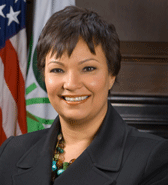
The new administrator of the Environmental Protection Agency, Lisa Jackson. (Courtesy of the EPA)
GELLERMAN: From the Jennifer and Ted Stanley Studios in Somerville, Massachusetts. This is Living on Earth. I’m Bruce Gellerman, in for Steve Curwood.
The new head of the US Environmental Protection Agency has her work cut out for her. Administrator Lisa Jackson trained as chemical engineer. Now she oversees an agency with 18,000 workers and the nation’s environment.
One of the first issues confronting her is toxic chemicals in the air around America’s schools. A recent USA Today investigation, using the EPA’s own data, found hundreds of schools where students were exposed to industrial pollutants at levels far exceeding federal standards.
From toxic chemicals to the threat of climate change - it’s Lisa Jackson’s responsibility to come up with the answers - and we called her up to ask her the questions. Ms. Jackson, welcome to Living on Earth.
JACKSON: Well thanks for having me.
GELLERMAN: So how’s the new job?
JACKSON: Well, it’s overwhelming. The D.C. expression is drinking from a fire hose, but everyday is a little bit better and the extraordinary staff here at the EPA have just been doing a fantastic job getting me oriented again. Or I should say reoriented back to the agency.
GELLERMAN: Yeah, you worked there many years ago.
JACKSON: Yeah, the years are starting to pile up. I was here sixteen years altogether. A couple years in Washington D.C. and most of my time spent in the New York City regional office.
GELLERMAN: Well let’s talk about the USA Today series, “The Smoke Stack Effect.” It found that there were extremely high levels of toxic air pollution around hundreds of the country’s schools. And that was published around the same time you were nominated to lead the EPA. What was your reaction to the series?
JACKSON: You know, I think every parent who read that story or who saw the headlines or even heard about it had some level of concern. And, you know, talking with the USA Today reporters, I think what they wanted to do, they were very successful in doing which was asking the right questions and questions that I think it’s fine for EPA initially to say we don’t know, but what I hope our response has been is that it’s our job to know, to find out, to be able to say, to speak to parents and give them information so that they can feel more at ease - or, alternatively, ask for more to make sure that at the end of the day they feel comfortable about the school environments for their children. We’re embarking now on a several month long partnership with states and local entities to do modeling around those schools where we think we’re most likely to see problems, to try to get additional information to bring to bear on this.
GELLERMAN: Well what can you do if you do find a problem at these schools?
JACKSON: Well, EPA’s authorities are great, states and locals are great and sometimes the most important thing is to get that information out to parents, because as a mother, I know that if a parent thinks that their school is unsafe, they’re gonna begin to be our biggest advocates for action. You know, first thing we’ll do is make the local authorities aware of the information we have so that we can all work together to come up with a solution.
GELLERMAN: So you’d use the Clean Air Act to regulate these hot spots if need be?
JACKSON: Sure. We could use our authorities under the Clean Air Act. You know, EPA is required since 1990 to limit emissions of air toxics. These are chemicals that have the potential essentially to cause cancer and other serious health effects. And since 1990, EPA has issued 96 regulations covering about 174 categories of industrial chemicals. And, you know, the data show that between 1990 and 2005, emissions of air toxics have actually declined by 41 percent, largely due to EPA regulation, although there’s certainly lots of categories left to be addressed. And I think what the story, especially with schools goes – brings to bear is the issue that, you know, overall reductions in toxic levels are certainly important and first and foremost EPA is concerned about the quality of our air as a whole, but hot spots – schools located near sources – the general reduction doesn’t necessarily mean that we’ve done our job. Children’s health is still not being protected. And those issues mean that we have to give special attention to potential hot spots of contamination. But again, as a parent, my experience is that any number of folks will be more than happy to advocate with us and work with us to address any concerns.
GELLERMAN: I want to switch gears a bit now.
JACKSON: Sure.
GELLERMAN: You know, it’s almost two years that the Supreme Court handed down its historic ruling. It was Massachusetts verse the EPA. And it ruled then that the EPA can regulate carbon dioxide as an air pollutant under the Clean Air Act. I’m wondering, what are you going to do with that authority now?
JACKSON: Well, what the Supreme Court said, Bruce, was that EPA – it required EPA to make a finding, affirmatively or not, as to whether green house gases endanger public health and welfare. And so for two – almost two years now – EPA has owed something, if you will, to the American public. And that’s a statement on a fairly fundamental issue. The reason that lawyers and regulators and lot of people who watch Washington are concerned is because, if EPA makes a finding of endangerment as it’s called – that finding can trigger EPA’s regulatory authority under the Clean Air Act to address climate change. But, I like to think of it more as the average citizen. I think it’s reasonable for the average citizen to expect the Environmental Protection Agency to have an opinion on whether green house gases endanger public health and welfare, And so we are expediting getting a finding either way out to the American people.
GELLERMAN: It’s a very tantalizing answer you gave there.
JACKSON: [Laughs]
GELLERMAN: April 2nd is the two year anniversary – you think you’ll have an answer for the public by then?
JACKSON: No, you know, Bruce, I don’t wanna get wrapped up in one particular date. I think what I’d like the public to know is a couple things. First, as head of the Environmental Protection Agency under President Barack Obama, I take very seriously our responsibility to speak to the American people on the issues of the day, and climate change and greenhouse gases is one of them. So we will expedite our work. I would not advise anyone to put money down on April 2nd as the date. I think instead what I’d like people to know is that we’re gonna get a determination out one way or the other as soon as possible, and it will be subject to public comment, and I’m sure it will engender much of that.
GELLERMAN: So what do you think is the best way to regulate CO2, if you had to? Would it be EPA regulations or do you think Congress should take a role in this and come up with new laws?
JACKSON: Well, I think new legislation that specifically is designed to address climate change is optimal. It probably puts to bed a world of potential lawsuits that are waiting to happen and will give very clear direction, obviously law, in the issue. But what we’ve also said is that we know we owe some things to the American people, and we know that we owe them a robust look at the endangerment issue, public comment and, if indeed regulation turns out to be a path that we will travel, we will do it deliberately, but we will do it mindful of the importance of this issue on the environmental agenda of the American people.
GELLERMAN: There are some businesses that say if the Environmental Protection Agency were to regulate CO2 emissions, they might have to close down, especially in this economic environment.
JACKSON: Well, you know, there are any number of doomsday scenarios with respect to regulation that I think it’s part of my job also to assure people that we’re not going to pursue. One of the reasons legislation is better is that it gives clear direction on to what’s regulated and what’s not, and it allays some of the concerns that EPA will begin regulating small businesses and tiny sources. I think it’s important for us to remember that major sources of green house gases are still our transportation – how we get around as a people, as a nation – and how we generate power. And President Obama has given us clear direction, both in the Recovery Act he just signed and his upcoming budget that he believes that the new energy economy, renewable energy, and energy efficiency should all be part of our economy going forward. And so there are lots of things we can do on energy and transportation that will help to move us along a path to a new energy future and a new low carbon future.
GELLERMAN: Well you are getting a lot more tools in terms of dollars from President Obama’s proposed budget.
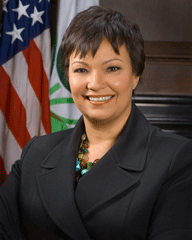
The EPA Administrator Lisa Jackson.(Courtesy of the EPA)
GELLERMAN: Well, I am going to ask you to choose your top three priorities for the money.
[LAUGHING]
GELLERMAN: What would you do with it?
JACKSON: Oh man, let’s see. I think, I’d like to talk less about programs for our first meeting, Bruce, and talk more about the importance of restoring the American public’s trust that EPA is first and foremost a science based organization. That we need to be a place where American’s look to get answers and American’s need to believe that those answers are based on the soundest science that we can possibly muster and without regard to politics, if you will. That the environment is clearly a nonpartisan, nonpolitical issue at its heart. People care about the places where they live and work. So we’ve talked a lot about making sure that agency scientists are – and their science – are respected and conversely, that they live up to awesome responsibility of being a voice for the environment and public health in this country.
Second, we talked about restoring the rule of law at this agency. I wouldn’t call it lawless, but we’ve had some – a number of cases where our major regulatory actions, especially on air, have been overturned by the courts. And what’s really disturbing there is that, in the mean time, a framework for protection of human health is undermined.
Finally, we’ve talked a lot about transparency and the importance of people being able to see inside this agency and feel assured that no individual stakeholder or special interest is making the agenda, that our agenda is governed by an open dialogue with all stake holders, environmental groups, industry advocates of all types, and then we move on based on science and the law. You know, this EPA, the Obama EPA is on the job, and all we can ask of the American people is that we be given an opportunity to earn their trust and to have them see us as a steward of the issues that they care about. That is our fundamental job here at EPA.
GELLERMAN: Ms. Jackson, you – you have a lot on your plate.
JACKSON: [Laughs] Thanks. But it’s a great job.
GELLERMAN: Well Administrator Jackson, I want to thank you very much for talking with us, and let’s do it again sometime soon, okay?
JACKSON: That’d be great, Bruce. Look forward to meeting you as well. Thank you so much.
GELLERMAN: Lisa Jackson is the Administrator of the Environmental Protection Agency.
[MUSIC: James Taylor “Inner Mystic Love” from New World (Real Self Records 2009)]
GELLERMAN: Just ahead – It’s not a drop in the ocean…The Great Lakes get a bucket full of cash to clean up their act. Keep listening to Living on Earth!
Related links:
- For more on Lisa Jackson and the EPA, click here
- The EPA’s Schools Monitoring Initiative
- The USA Today series “The Smokestack Effect”
- Listen to Living on Earth’s interview with USA Today reporter Blake Morrison
[CUTAWAY MUSIC: James Taylor: Rochester Raining” from New World (Real Self Records 2009)]
Toward Healthier Waters
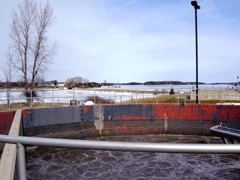
The village of Clayton’s sewage treatment ponds are just a few hundred feet from the St. Lawrence River. (Photo: David Sommerstein)
GELLERMAN: It’s Living on Earth, I’m Bruce Gellerman.
For decades the Great Lakes have been in deep trouble. They contain a fifth of the world’s fresh water but the five lakes suffer from massive pollution, degraded wetlands and invasive species.
Cleaning them up will cost tens of billions of dollars - and as North Country Public Radio’s David Sommerstein reports, President Obama’s economic stimulus package makes a down payment to begin the process.
[SOUND OF RIVER IN WINTER]
SOMMERSTEIN: The ice is finally breaking up on the St. Lawrence River. But it’s still frigid outside. This is the Thousand Islands region of Upstate New York, where the eastern-most Great Lake, Lake Ontario, empties into the St. Lawrence. Pine-crested islands with quaint cottages dot the channel. Canada’s on the far shore of the steel blue expanse.
It’s a long way from the industrial hum of Buffalo, Detroit, or Chicago. But even here, the water isn’t as clean as it looks.
[SOUND OF RIVER IN WINTER]
SOMMERSTEIN: I’m standing here on the docks of the village of Clayton right here on the St. Lawrence River. Right where I’m standing is one of the outflows of the village of Clayton’s sewer system, so on really rainy days, poorly treated sewage will actually spew out into the St. Lawrence River right here.
[SOUND OF TREATMENT PONDS]
CADDICK: Clayton’s sewer system was put in a century ago.
SOMMERSTEIN: Jennifer Caddick points to treatment ponds just a few hundred feet from the water. She directs the environmental group, Save the River. Caddick says towns like this don’t have money to upgrade.
CADDICK: Throughout the whole Great Lakes region, hundreds of billions of gallons of untreated sewage or poorly treated sewage are released into our waterways each year.
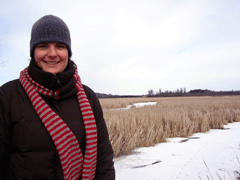
Jennifer Caddick of Save the River is bundled up on French Creek, a tributary of the St. Lawrence River that provides critical wetlands habitat. (Photo: David Sommerstein)
And there’s almost half a billion dollars more for a battered watershed. Toxic sediments from Rust Belt factories poison fish and endanger human health. Jeff Skelding says more than 180 invasive species have entered the Lakes, most of them hitchhikers in the ballast water of foreign ships….
SKELDING: Causing incredible disruption of the food web and the ecological system.
SOMMERSTEIN: Not to mention billions of dollars in economic damage every year.
Skelding is national campaign director for the Healing Our Waters-Great Lakes coalition. He says now the Great Lakes are on the map.
SKELDING: At the highest levels of power in Washington, we have two strong Great Lakes champions.
SOMMERSTEIN: That would be President Obama and his Chief of Staff, Rahm Emmanuel, both Illinoians.
It’s an about face from the previous administration. President Bush did convene more than a thousand stakeholders to hammer out a strategy for cleaning up the Great Lakes in 2005. Skelding says there was lots of lip service but not a lot of money.
SKELDING: It was a very heady time. President Bush had issued an executive order declaring the Great Lakes a national treasure and setting up the regional collaboration. The challenge became how do we secure the funding. It was at that point that things began to slow down.
SOMMERSTEIN: Things only sped up during the presidential campaign. Then candidate Obama vowed to create a $5 billion trust fund for the Lakes. Supporters see the new budget plan as a down payment on that promise.
New York Democratic Senator Kirsten Gillibrand says the money will help the region’s decimated economy as much as its environment.
GILLABRAND: Through new construction, through tourism dollars, through property value impact. It’s something that’s real. So I’m hopeful that we can make the case to our colleagues that investing in the Great Lakes is a win-win for everyone.

The village of Clayton’s sewage treatment ponds are just a few hundred feet from the St. Lawrence River. On really rainy days, the sewage backs up into the river.(Photo: David Sommerstein)
STACK: It’s unrealistic and unfair to think that the U.S. can and will clean up the Great Lakes without Canadian input. They simply can’t do it.
SOMMERSTEIN: So far, Canadian Prime Minister Stephen Harper has been quiet on matching Obama’s commitment.
[SOUND OF CRUSHING ICE]
SOMMERSTEIN: Back in northern New York State, environmentalist Jennifer Caddick tests the ice on French Creek, a tributary of the St. Lawrence River. She says wetlands like these are the heart and lungs of the Great Lakes.
CADDICK: If you come out here in the spring and summer, it’s really incredible, you can see the fish migrating up to spawn, or heading back to the river after they’ve been born, there’s lots of birds chirping around, lighting on all the cattails and other wetland vegetation here, so this is really a thriving area for wildlife in the region.
SOMMERSTEIN: The Bush-era clean-up blueprint called for $20 billion in projects to bring the Great Lakes back to health by restoring wetlands that have been plowed under for strip malls, for example.
So far, many environmentalists are hopeful President Obama is the guy who’ll get some of those projects done.
For Living on Earth, I’m David Sommerstein in Clayton, New York.
Related links:
- Healing Our Waters
- Save the River
- Great Lakes 2005 Regional Report
- Obama's promise to create a $5 billion restoration fund
- The Brooking's Institution Report: Healthy Waters, Strong Economy; the Benefits of Restoring the Great Lakes Ecosystem
[MUSIC: Jonathan Richmond “Music For Next Years Jukebox” from Revolution Summer (Vapor Records)]
The Bus Stops Here

More than $8 billion in economic stimulus money will pay for new streetcars, buses, and trains, but not operating costs like wages for bus drivers or train conductors. (Photo: Thomas Hawk)
GELLERMAN: For President Obama, the road to economic recovery begins in the fast lane to the Department of Transportation.
A week before the DOT was supposed to get $26.6 billion authorized in the stimulus package, the President traveled to the Transportation Department to hand over the money.
OBAMA: Transportation projects that were once on hold are now starting up again as part of the largest new investment in America’s infrastructure since President Eisenhower built the interstate highway system.
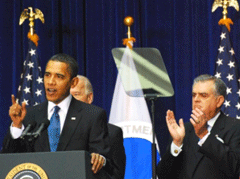
President Obama and Vice President Biden visit the Department of Transportation to announce the release of $26.6 billion to fund highway infrastructure projects. Secretary of Transportation Ray La Hood is on the right. (Courtesy of the Department of Transportation)
Matthew Welbes, a senior official with the Federal Transit Administration, says $8.4 billion goes to public transportation.
WELBES: The way the Congress wrote the law, it’s money for capital purchases, so it’s for buying new buses, it’s for buying new subway and street cars, it’s for fixing up passenger stations, fixing up the maintenance facility where the buses and the rail vehicles are maintained. And there’s a significant backlog of investment needed to make our public transportation service really, really better quality for the customers, and to make it move more efficiently. And so, these resources will help recapitalize our nation’s transit assets.
GELLERMAN: But it’s not going to help places like St. Louis that’s really hurting. It’s going to be cutting 2,300 bus stops out of 9,000. It’s cutting a quarter of its staff, just at the end of March.
WELBES: Bruce, it’s something we’re observing really across the country right now. And we’re seeing sales revenues that are often the funding source, local funding source for public transportation declining, as the – during the economic downturn. Right now, federal transit funding comes in part from the gas tax. The gas tax has remained in the same place since 1993. And so we’ve seen an erosion of about a third in the, you know, value of the gas tax, particularly as it’s declined, you know, due to inflation. So 2.86 cents out of the 18 cent gas tax goes to public transportation. But as people have stopped driving as much and using as much gasoline and more importantly, as a lot of vehicle sales have declined, the funding that supports both highways and mass transit is declining. And so, while we’re seeing transit ridership at record levels. We also see this revenue decline.
GELLERMAN: You know Mr. Welbes, United States government is bailing out the banks and the insurance industry and the auto industry and I don’t think anyone intends that this stimulus money be used as a bailout for public transportation, but what’s the answer. How can we make public transportation self sufficient?

Nearly $27 billion has been allocated for creating jobs in bridge and highway repairs. (Courtesy of the Washington State Department of Transportation)
GELLERMAN: I know there was a Congressional blue ribbon commission just recently came out with the funding saying okay, we’ve gotta in the short term raise the tax on gasoline at the federal level and then we’ve gotta switch over to something completely different- we’ve gotta get into some kind of tax on the miles you actually drive in your car.
WELBES: That’s right, there are two different commissions, they are federal commissions and in the last year both of those commissions reached somewhat the similar conclusions, and they’re recommendations involve raising the gas tax or indexing the gas tax to inflation over time, looking at vehicle miles traveled charges. The President has noted that at this moment we have an economic downturn - raising the gas tax is not on the to do list.
GELLERMAN: So how would a fee on the miles driven work exactly?
WELBES: Sure. The way it would work is a car would have a transponder on it., And as you drive it would record where you’ve driven, when you’ve driven. And for example, in a test that was done out in Oregon a few years back, at the time I believe, a person pulled their car into a gas station it would record some key information and the individual’s car would then be charged based on their travel. And so it’s information about, you know, the time of day when one’s traveling and how far one’s traveled, where one’s traveled and so it’s a more discrete charge in the same way that you’d pay a different fair to fly on an airplane depending on what time of day you choose to fly.
GELLERMAN: Boy, can you say Big Brother?
WELBES: Well, that’s one of the concerns. I think First Amendment concerns are among one of the issues that would need some sort of resolution. I know that proponents of VMT charges have described the ability to make anonymous such information. I think that’s something that people interested in the First Amendment would want to understand more clearly, but it’s one of the issues to resolve.

More than $8 billion in economic stimulus money will pay for new streetcars, buses, and trains. (Photo: Thomas Hawk)
WELBES: It’s substantial. I think one of the things we learned last summer is that four dollars a gallon is a point where people dramatically change their travel behavior and what we’re also now seeing this that because of the economic downturn, some of the things that happened over the summer remain in place. And you know, we experienced a notable increase in public transportation use during the past year as well for those same two reasons.
GELLERMAN: You know, transportation needs roads and bridges and those types of things. Those are planned decades in advance. Could it be that we’re planning the wrong transportation mix for the future, that is as ridership increases on public transportation, and miles driven goes down, maybe we got it wrong.
WELBES: As we go forward in our country, we want to be sure that we make investments not only in transportation but in the way we develop our land and we build our housing and our businesses so we can create choices for people, so that they can choose to travel by transit to get to school, to reach work, to visit the doctor or even to design communities so that there are trips that are not taken, so that in order to get that loaf of bread or to get a hair cut, a person can walk to some place near by. And so if we create urban forum that is less auto oriented, more supportive of transit and walking, we create places where in the future our investments will support lower emissions and fewer green house gases.
GELLERMAN: Matthew Welbes is acting deputy administrator for the Federal Transit Administration. Mr. Welbes, thanks a lot.
WELBES: Thank you Bruce
[MUSIC: Andrew Bird “Tenuousness” from Noble Beast (Wegawam Music 2009)]
Note on Emerging Science
GELLERMAN: Coming up – mud, glorious mud – but first, this note on emerging science from Jessie Martin.
[EMERGING SCIENCE THEME]
MARTIN: On the morning of December 26, 2004, a wall of water one hundred feet high came crashing onto the shores of the countries surrounding the Indian Ocean. The Asian Tsunami killed over 200,000 people and destroyed the homes and fishing boats of many more.
Four years later, a group of researchers from the Universities of Liverpool and Aix Marseille think they’ve come up with a way to protect coastlines from tsunamis and other large waves. Their idea is to build a structure similar to a levee off the shore of tsunami prone areas. But unlike a traditional levee that blocks waves, the new design uses a series of pillars to deflect the water along concentric corridors. The water would move around the levee columns and exit to either the left or the right of where it entered, leaving a calm, wave-free region in between.
The scientists believe that the levees would be relatively easy to make. The pillars could be constructed from any hard, nonporous material available, including tree trunks anchored to the ocean floor. A levee that’s a hundred yards in diameter – the length of a football field – would create a forty yard wave free zone. That’s not a long stretch - but the researchers believe it’s long enough to provide a safe place for people to gather and wait out a tsunami.
So far, the scientists have successfully tested their design using a small scale model. The next step is to build a full sized levee – one that will protect villages from oversized waves.
That’s this week’s note on emerging science. I’m Jessie Martin.
Mud Season
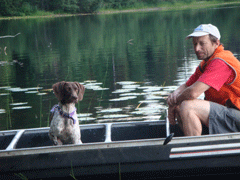
Rick Bass and his dog, Auna. (Courtesy of Rick Bass)
GELLERMAN: March roars in like a lion and skips out like a lamb - and in between there’s mud - as Montana writer Rick Bass knows well.
BASS: At no point of the year are we more incorporated into the seasons, more completely owned by the world, and the woods. Summer and autumn, and even the first holidays of winter, are traditionally the seasons we think of as most easily summoning the joy of the human condition. Yet in February, March and April, the slog-o-matic mud season, never are we quite so owned by the beautiful world. Beaten down, made malleable as if by the accruing weight of the ivory snow itself, we become tempered to the very shape of the land. We become fitted to its rhythms and processes as surely as if we were buried by that snow and are pressed flat against the darkened ground, our bellies spooned against each curve of soil, each swell of stone. The snow above presses down, pushes on our backs and arms and legs, kneading and sculpting us, while at the same time it impresses upon us some deeper, unspoken counsel.
On the surface, there's very little difference. In fact, the sameness seems to be spreading, as the snow, which initially mimicked the sleeping shapes of every humped and curved and buried thing, becomes deeper, smoother, more homogenous.

Rick Bass and his dog, Auna.(Courtesy of Rick Bass)
Everything still seems the same, in March. But beneath the snow, and within our blood, there are stirrings that tell us, in our own small changes, that the land is changing too.
[MUSIC: Jenny Scheinman “Processional” from Crossing The Field (Kich Records 2008)]
GELLERMAN: Writer Rick Bass lives in the Yaak Valley near Troy, Montana. This essay is from his forthcoming book, “The Wild Marsh”.
You can hear our program any time on our website or get a download for your MP3 player. The address is loe.org. That’s loe.org. There you’ll also find pictures and more information about our stories, and we’d like to hear from you. You can reach us at comments at loe dot org. Once again, comments at loe dot org. Our postal address is 20 Holland St, Somerville, MA 02144. And you can call our listener line at 800-218-9988. That’s 800-218-9988.
Just ahead – protesting coal, past and present. Demonstrators take to the streets today, in 1914 a miner’s strike turned deadly.
ANDREWS: They understood, you know it was really their labor that made this world go round, and so they understood that by cutting off the flow of energy to the broader society, that that was really the strongest lever that they had to secure what they wanted.
Demonstrating against coal, then and now. Coming up - on Living on Earth.
ANNOUNCER: Support for the Environmental Health Desk at Living on Earth comes from the Cedar Tree Foundation. Support also comes from the Richard and Rhoda Goldman fund for coverage of population and the environment. And from Gilman Ordway for coverage of conservation and environmental change. This is Living on Earth on PRI, Public Radio International.
[CUTAWAY MUSIC: James Taylor: “New World” from New World (Real Self Records 2009)]
Related links:
- Rick Bass Background
- Rick Bass Collection, Texas State University
Turning up the Heat on Coal
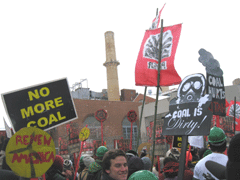
The first mass civil disobedience in the U.S. aimed at coal and climate change, according to organizers of the Capitol Power protest. (Photo: Jeff Young)
GELLERMAN: It’s Living On Earth, I’m Bruce Gellerman.
[CHANTING: “COAL HAS GOT TO GO, COAL HAS GOT TO GO.”]
GELLERMAN: Police in the nation’s capital estimate 2,500 demonstrators recently took to the streets of Washington, DC. The protesters blocked the gates to the coal-burning power plant that heats and cools the US Capitol and many nearby federal office buildings.
Despite the frigid cold weather - and the possibility of arrest - the protesters wanted to bring the fight against global warming to the threshold of Congress.
As Living on Earth’s Jeff Young reports, demonstrators are increasingly using civil disobedience to fight against coal.
YOUNG: NASA scientist James Hansen has been sounding the alarm on global warming for more than 20 years. But even for him, this was new. The renowned climatologist has risked his reputation at congressional hearings and scientific gatherings, by pushing his view of what rising CO2 levels could bring. But now he’s risking something else. Arrest.
HANSEN: Well I can’t let these, I can’t talk about this and then let young people get arrested and I stand back, behind them.
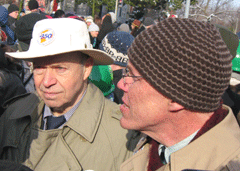
Author Bill McKibben (right) and NASA scientist James Hansen help block the gates to the U.S. Capitol Power Station. (Photo: Jeff Young)
HANSEN: I wouldn’t say I’m an activist. I’m trying to make clear what the connection is between the science and the policy implications. Somebody has to do it!
YOUNG: You know, you have a president in office who’s taking actions to address climate change, why protest now?
HANSEN: Ahh. I think that’s a very good reason, because they’re going to take positions in the near future. So I initially didn’t like the idea, because Obama had not had time. But after thinking about it I decided this is the time to make clear what is needed in order to preserve species and the planet that’s existed for the past 10,000 years.
YOUNG: With that, Hansen joined the march to the smokestacks a few blocks to the
south.
[MARCHING, CHANTING]
YOUNG: It’s not an isolated act. In the last year there were at least eleven incidents of civil disobedience aimed at coal in the US. Coalfield residents blocked mines and power plant construction sites. Activists occupied offices of banks that finance power plants. And the actions show no signs of stopping since the change of power in Washington. If anything, they’re gaining momentum, with a half dozen protests since Obama took office.
MCKIBBEN: What we’ve got to do is give Obama the space he needs to work.
YOUNG: That’s environmental author and activist Bill McKibben, who helped organize the capitol power plant protest along with Greenpeace and Rainforest Action Network.
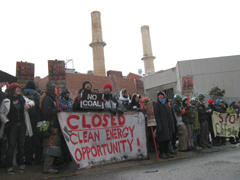
Did it work? When Congressional leaders caught wind of the coming demonstration, they decided to phase out the use of coal at the capitol power plant.(Photo: Jeff Young)
[CHANTING: “CLEAN IT UP! SHUT IT DOWN!”]
YOUNG: Luke Popovich watched McKibben’s anti-coal army pass by the capitol power plant. Popovich kept a low profile in a trench coat and ball cap. He’s a spokesperson for the National Mining Association, and he was not impressed with what he saw.
POPOVICH: I don’t really think a protest like this menaces an industry that provides 50% of the electricity to Americans. If these people are genuinely interested in preventing climate change and the buildup of greenhouse gases what they ought to be doing is joining with others to support development of clean coal technology.
[CHANTING: “CLEAN COAL? HELL NO! THAT’S A MYTH THAT’S GOT TO GO!”]
YOUNG: So-called “clean coal” would remove CO2 from coal emissions. But even industry experts say the technology is probably a decade away. Critics say it might never work at the scale needed. And if it does come about, clean coal does nothing about the damages from mining, something country singer Kathy Mattea addressed in song.
MATTEA [OVER GUITAR]: Alright, so this is a song about dirty coal on the front end, not the back end. We’re watching what happens when coal burns, well this is what happens when people start blasting off the tops of mountains, and doing all kinds of unthinkable things because of our appetite for energy. [SINGING] “I come from the mountains, Kentucky’s my home…”
YOUNG: In the coal counties of southern West Virginia and eastern Kentucky the long fight over mountaintop removal mining is reaching a new, pitched level with civil disobedience.

Organizers say the Capitol Power protest was the first mass civil disobedience in the U.S. aimed at coal and climate change. (Photo: Jeff Young)
JOHNSON: We use as our primary scripture psalm 24-1. It says “the Earth is the Lord’s and everything in it.”
YOUNG: Johnson knows the direct actions he’s joining could backfire if they alienate the culturally conservative communities he hopes to win over.
JOHNSON: It has to be done carefully, with excellent discipline, nonviolently, with respect to the law enforcement officials, to the neighbors. We want to win the hearts and minds of people. But we do feel that the regulatory system and the state government hath broken down. I’ll say it point blank: they are in the pockets of coal and beholden to the coal interests.
YOUNG: Johnson says more coal country activists plan to be arrested in the coming weeks. But back at the capitol power plant…
[CHANTING: “WE SHUT THEM DOWN”]
YOUNG: …chilly hours passed without any action by police. Roads and gates were blocked, federal property trespassed upon and still, capitol police made no arrests. Eventually James Hansen and the other demonstrators declared victory and walked away.
HANSEN: Yeah I think this was a huge success and a step in the right direction. But it’s not the end. We can’t stop here.
YOUNG: Any disappointment at not getting arrested?
HANSEN: No! I have a lot of work to do. I would much rather get back to that! [Laughter]
YOUNG: The capitol power plant issue had already been settled, anyway, with a letter late last month from congressional leaders Nancy Pelosi and Harry Reid. They instructed the power plant manager to phase out coal in favor of natural gas. A small, symbolic victory that anti-coal activists promise will not be the last.
For Living on Earth, I’m Jeff Young in Washington.
Related links:
- Hear more of Jeff Young’s conversation with author Bill McKibben.
- For more of Jeff Young’s conversation with author Wendell Barry, click here.
- Listen to Kathy Mattea talk and sing about what coal has done for and to her home state.
- Hear more about coal country communities dealing with mountaintop removal.
- The wiki-style watchdog SourceWatch keeps tabs on protests and direct action aimed at coal.
Killing for Coal

GELLERMAN: Coal's been generating controversy for about as long as it's been generating energy.
On April 20th 1914, coal was at the epicenter of the bloodiest battle in US labor history. It’s called the Ludlow Massacre, after the mining town in Southern Colorado where coal miners went on strike demanding better conditions. The Colorado National Guard attacked a tent colony of striking miners and their families - 20 people were killed - most, women and children.
Thomas Andrews teaches history at the University of Colorado Denver. He chronicles the epic strike and its aftermath in his new book, "Killing for Coal: America's Deadliest Labor War." Professor Andrews, welcome to Living on Earth.
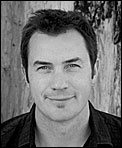
Author Thomas G. Andrews.
GELLERMAN: Let’s talk about the importance of coal, the rock that burns. It basically sets the stage for what you wind up calling an inevitable disaster.
ANDREWS: Right. Coal sort of enabled people to tap into the energy of ancient suns, massive reserves of energy that had been synthesized by the marshlands that had once flourished about 70 million years ago as the Rocky Mountains started to emerge. It actually provided this sort of vast reserve of energy that fueled the development of the western economy. You know, Colorado during the indigenous period and even sort of the early frontier period had been fairly energy scarce. Water power was very difficult to use. Not a lot of timber, so given this sort of energy scarcity, coal turned out to be an economic godsend at least from a capitalist perspective.
GELLERMAN: You site a report by the Denver chamber of Commerce in 1907, that says, “we can not exist without it.”
ANDREWS: Yeah, by the early 20th century, the people of this region had become totally dependent on it. Almost everybody in the region was either a direct or an indirect consumer of coal.
GELLERMAN: I want you to read from your book, if you might, page 84, see where it says, “Had coal suddenly vanished on a winter’s day.”
ANDREWS: Yep. “Had coal suddenly vanished on a winter’s day around 1900, a long forgotten silence would have replaced the clanking, whistling, screeching world of steam. Virtually all train traffic in the West would have stopped, halting the flow of people and goods between hinterlands and metropolis, western cities sand outside markets. Country folk, cut off from so many necessities of life, would have scurried to the pantries and cellars to see how long their stores of food and fuel could last. City dwellers meanwhile would have maneuvered around street cars stopped dead on their tracks. For a time, horse drawn wagons and buggies cob webby with disuse might have been drawn into service. But before long horses, livestock and poultry would have devoured every last vestige of browse, grass and refuse. If the hungry human population had not eaten the animals first that is. Only the trees guarded by force would have remained standing, for people would have needed wood not simply to stave off the cold, but only to cook their diminishing food supplies.”
GELLERMAN: So coal becomes a resource, very rapidly, of life or death.
ANDREWS: Yeah, basically.
GELLERMAN: The coal is discovered there by a geologist called William Jackson Palmer, and he has a real talent for finding coal in these out crops of rocks. And when he looks at the rock he sees in them what he calls an industrial utopia.
ANDREWS: Right. He had this sort of idea that he could create industries where harmony would prevail between capitalist and workers. As he put it there would never be any strikes or hard feelings. And he had this really sort of amazing diverse contradictory background. He had been a highest ranking Quaker in either army during the Civil War. He had a very good background as a businessman , he was also a mining engineer, well versed in geology. But he was also sort of a romantic, a dreamer. And Palmer was the first to sort of confirm the extent and quality of the coal deposits. And he was the first to sort of dream this sort of utopian future for the region, and coal was central to his vision of what the mountain west could become.
GELLERMAN: It was anything but a utopia for the workers, though.
ANDREWS: Yeah. Conditions were very, very difficult. Both underground and on the surface. You know I liken going into a coal mine to going down in a submarine or going out into outer space. These men were going down into places that hadn’t had oxygen for tens of millions of years. And so they were surrounded by this alien environment that posed incredible dangers to them. They were trying to systematically remove an entire strata of the earth without it falling down on top of their heads. When coal dust got into mine air, it sort of dried out and became very explosive. A lot of the mines contained large amounts of methane, falls of rock and coal felled miners almost every day. And they were only paid for work that directly extracted coal. Anything else, all those tasks that might help safe guard their life like setting a proper of timber to hold the roof up over their heads, they didn’t get paid for that for their labor. They always had to make these very very difficult calculations. You know, I mean should they play it safe and at the end of the month have less pay in their envelope to take home to their families. So I think it was a very tense and sort of fraught way of living.
GELLERMAN: I want to fast forward to about 1914. The miners were on strike for months. And the National Guard had been called out by the Governor. You’ve got these goon squads hired by the mines. You have the miners who are armed to the teeth. And then on April 20th 1914, things come to a head, things just ignite. I wonder if you could describe what happened.
ANDREWS: Yeah, I think it was, in my interpretation, this was a situation where both sides had come to expect the very worst from each other. And so you had a fairly small contingent of militiamen. You had a large tent colony. Shots broke out. It’s not clear who fired the first shot, but both sides were basically primed to fight. And at that point it was pretty much go time. Several people were shot over the course of the day. But most of the killing actually consisted of women and children who were asphyxiated when the tent above the cellar in which they’d been sort of secreted away caught fire. There were eleven children and two women who were killed as the fire raged above. And it was really the discovery of those bodies the next day that elevated this into a, you know, sort of event of national significance, and national outrage.
GELLERMAN: And then what ensues is The Great Coalfield War. The miners take revenge.
ANDREWS: Yeah, very much so. A lot of these miners had military backgrounds, you know, from all over the world. They’d fought in the Spanish American War, Italian North African campaigns, the Balkan Wars, other label battles. According to some militia men, the miners were actually better fighters than they were. And it’s remarkable how coordinated the miners were. For ten days they really sort of wreaked havoc in Southern Colorado. Really the sort of, you know, outburst of these pent up grievances.
GELLERMAN: And they take it out on coal.
ANDREWS: Yeah, they do. I mean, I think they were very sort of purposeful in the places that they attacked. So they destroyed six mines. They wiped two company towns off the face of the earth. And they killed upwards of thirty people. And they were well aware of sort of the metabolism of this industrial society. They understood that their labor, you know it was really their labor that made this world go around. And so they understood that by cutting off the flow of energy to the broader society, that was really the best, the strongest lever that they had to secure what they wanted.
GELLERMAN: I didn’t realize what a pivotal role women had played in this. There’s mother Jones, who’s a labor organizer for mines from the East. She comes there and she winds up getting you know arrested. And it’s the women who march onto the governor’s house and in the state capitol and basically bring things to a peaceful end.

GELLERMAN: And very quickly after that in 1920, women get the right o vote.
ANDREWS: Right, nationwide.
GELLERMAN: It’s interesting that coal bisects so much of the American southwest story and the American story.
ANDREWS: Yeah, you know, I think coal is incredibly significant in American history. And given its significance I’m always shocked when I, you know, open a synthesis of American history or college textbook – coal often isn’t there are all. When it is there it’s just sort of in bits and pieces. And so we have this incredibly crucial substance in our past and in our present and likely in our future that we, I think for the most part, don’t understand particularly well.
GELLERMAN: Well Professor Andrew, thanks a lot. I really appreciate your time.
ANDREWS: Thank you so much. It’s been a pleasure speaking with you.
GELLERMAN: Thomas G. Andrews is a Professor of History at the University of Colorado Denver. His new book about the Ludlow Massacre is called "Killing for Coal: America's Deadliest Labor War."
[MUSIC: Woody Guthrie “Ludlow Massacre” from Hard Travelin: The Asch recordings Vol 3 (Smithsonian 1998)]
[SOUND OF BORNEAN BRISTLEHEAD]
GELLERMAN: We leave you this week in the company of the Bornean Bristlehead. Try saying that THREE times fast!
[SOUND OF BORNEAN BRISTLEHEAD]
GELLERMAN: The Bornean Bristlehead is a relative of the wood-swallow – but its head is a covered with bright red bristly feathers, with an orange top-knot. Bristleheads call out continuously as they travel deep into Borneo’s lush rainforest.
Their song comes to us from the Natural History Publications CD, “Voices of the Borneo Rainforest.”
Related links:
- For more about the book “Killing for Coal: America’s Deadliest Labor War,” click here
- For more about Thomas G. Andrews, click here
GELLERMAN: Living on Earth is produced by the World Media Foundation. Our crew includes Ashley Ahearn, Bobby Bascomb, Eileen Bolinsky, Ingrid Lobet, Helen Palmer, Mitra Taj and Jeff Young, with help from Sarah Calkins and Marilyn Govoni. Our interns are Lindsay Breslau, Liz Gross and Christine Parrish. Jeff Turton is our technical director. Alison Lirish Dean composed our themes. You can find us anytime at loe.org. Steve Curwood is our executive producer.
I’m Bruce Gellerman. Thanks for listening.
ANNOUNCER: Funding for Living on Earth comes from the National Science Foundation, supporting coverage of emerging science, and Stonyfield Farm: organic yogurt and smoothies. Stonyfield pays its farmers not to use artificial growth hormones on their cows. Details at stonyfield.com.
Support also comes from you our listeners, the Ford Foundation, the Town Creek Foundation, and the Oak Foundation, supporting coverage of climate change and marine issues; The Bill and Melinda Gates Foundation, dedicated to the idea that all people deserve the chance to live a healthy productive life. Information at gates foundation.org; and Pax World Mutual Funds: socially and environmentally sustainable investing. Pax World: for tomorrow. On the web at paxworld.com.
ANNOUNCER: PRI, Public Radio International.
Living on Earth wants to hear from you!
Living on Earth
62 Calef Highway, Suite 212
Lee, NH 03861
Telephone: 617-287-4121
E-mail: comments@loe.org
Newsletter [Click here]
Donate to Living on Earth!
Living on Earth is an independent media program and relies entirely on contributions from listeners and institutions supporting public service. Please donate now to preserve an independent environmental voice.
NewsletterLiving on Earth offers a weekly delivery of the show's rundown to your mailbox. Sign up for our newsletter today!
 Sailors For The Sea: Be the change you want to sea.
Sailors For The Sea: Be the change you want to sea.
 The Grantham Foundation for the Protection of the Environment: Committed to protecting and improving the health of the global environment.
The Grantham Foundation for the Protection of the Environment: Committed to protecting and improving the health of the global environment.
 Contribute to Living on Earth and receive, as our gift to you, an archival print of one of Mark Seth Lender's extraordinary wildlife photographs. Follow the link to see Mark's current collection of photographs.
Contribute to Living on Earth and receive, as our gift to you, an archival print of one of Mark Seth Lender's extraordinary wildlife photographs. Follow the link to see Mark's current collection of photographs.
 Buy a signed copy of Mark Seth Lender's book Smeagull the Seagull & support Living on Earth
Buy a signed copy of Mark Seth Lender's book Smeagull the Seagull & support Living on Earth

